Have you ever felt that spike of panic while hiking with your kids and this thought enters your mind: “what if my kid comes up on a rattlesnake while we’re hiking?!”
If that is you, I’m super glad you’re here. I’ve certainly felt that way, so I gathered tons of great info about snakes which I’ll share with you throughout this post. Let’s get into it…
The first step to staying safe from snakes while in the outdoors is knowing how to identify the common snakes in your area. Make sure before heading out on a hike that you know exactly what to look for and how to identify the potentially dangerous snakes that you could encounter. It’s extremely important to know what areas of the trail are the most common to see snakes in and what to do when you encounter one, especially if you’re hiking with kids!
This article is going to focus mostly on what snakes are common in California, since that is the area that I am most familiar with. I encourage readers that live or hike outside of California to use the resources below to identify the snakes in their home state.
I say this pretty frequently, and I’ll say it again: my goal is to help mothers feel as informed and empowered as possible so they can explore the wilderness with their kids and feel calm and confident doing so. I never want to instill fear or plant ideas of all the things that could go wrong on a hike. I do truly believe that knowledge is power, and I know it significantly reduces my own anxiety to feel prepared for anything. I’m glad you’re here! Let’s jump into it…

Disclaimer: the purpose of this article is to jumpstart the reader’s awareness of potential snake encounters while hiking. This is not a completely comprehensive guide to snake encounters. The reader is expected and encouraged to continue their own research. Additionally, this article absolutely does not include medical advice. The author is not a doctor or medical professional and should not be treated as such.
Never try to touch, pet, handle or relocate a snake without professional training.
In this article:
- Common habits of snakes on a trail
- What snakes are common in California
- How to avoid snake encounters
- Teaching kids to avoid snake encounters
- What to do if you are bitten by a snake while hiking
- Free Snake Relocation Directory (only to be used if a snake is on your home property and needs to be removed)
COMMON HABITS OF SNAKES ON HIKING TRAILS:
- They are usually active during the warmest hours of the day
- They hide in areas along the sides of the trail: under bushes, in tall grass, in between rocks, under logs
- Rattlesnakes can sound their rattle as a warning to stay away. However, if they are hunting they will not sound their rattle so they can stay more hidden, so don’t always rely on a warning rattle.
- Rattlesnakes (and other non-venomous snakes, too) are VERY good at camouflaging to protect themselves. They can blend in with rocks, dirt, under bushes, the gravel on a trail (especially in speckled sunny/shady areas), etc.
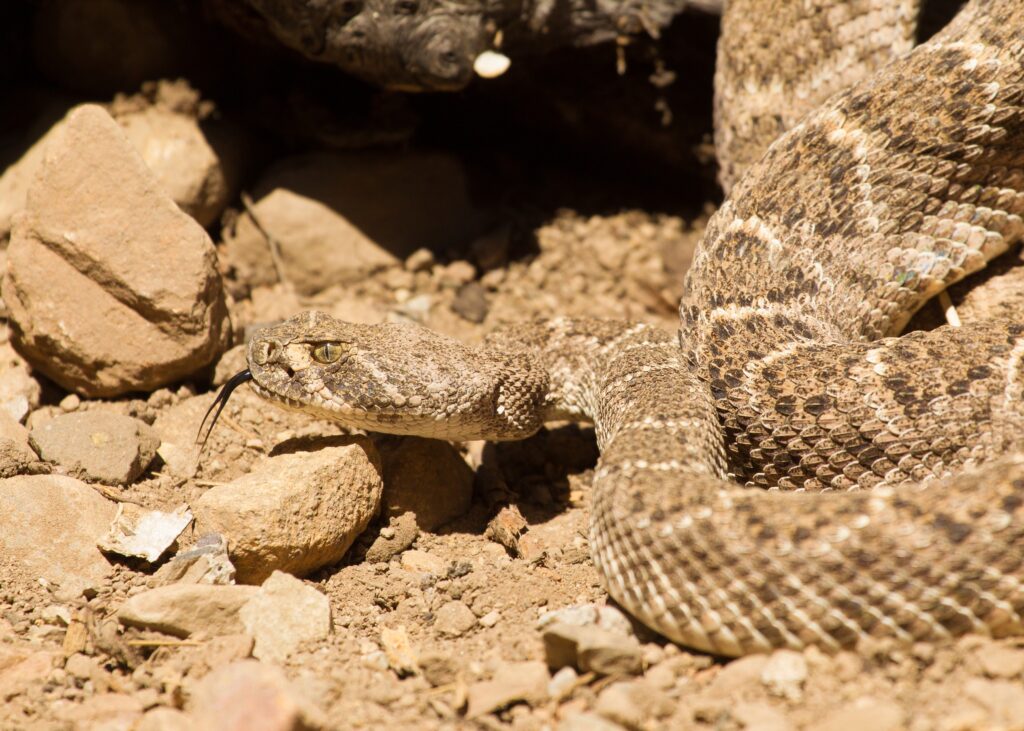
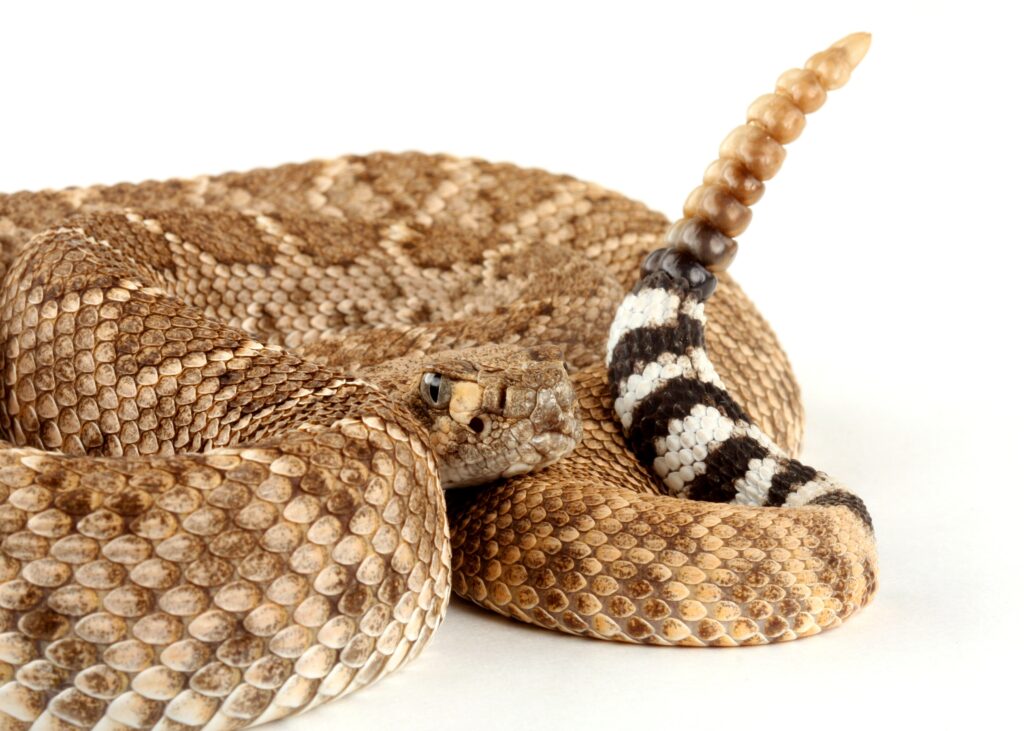
IDENTIFYING COMMON SNAKES IN CALIFORNIA:
There are many snakes that are present throughout California. I am going to highlight only a few that are the most common in my area of Coastal Central/Southern California. Check out the resources linked at the end of this post to learn about more common snake species here in California and in other states, too.
Whether you are in CA or another state, I strongly recommend browsing the iNaturalist website to see all the different kinds of snakes that are in your area. I’ll link the site in my “Sources” section at the end of this post. When you go to their website, click the “Explore” tab then enter your state and “snakes” in the search bar.
Venomous and Potentially Dangerous Snake in CA:
Rattlesnake
Of all my many, many snake sightings, the rattlesnake has certainly been the most common, by far. I have encountered countless rattlesnakes while hiking and mountain biking. Additionally, we’ve had them slither into our backyard as well.
There are common species of the rattlesnake such as, Western Diamondbacked Rattlesnake and Southern Pacific Rattlesnake, among several others.
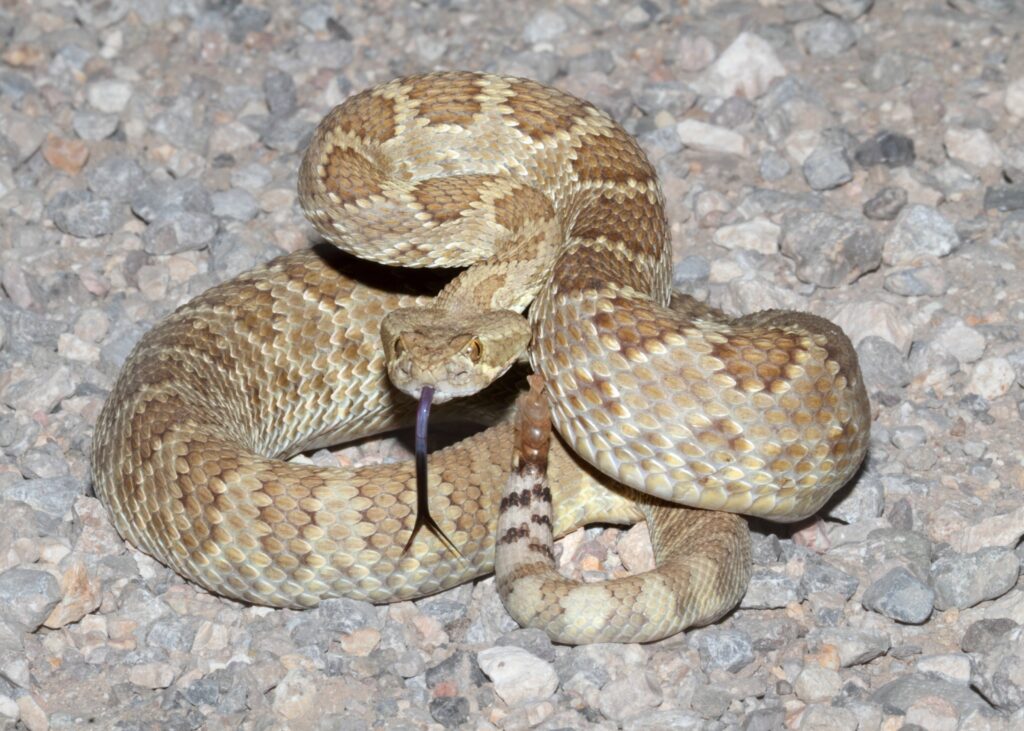
Encounters with rattlesnakes can go a number of ways:
1. The snake can continue slithering along. In this situation, the snake is usually unfazed by humans because it hasn’t been startled, approached too closely, or made to feel threatened. The best way to have this kind of experience is to always be on the lookout for rattlesnakes so you can quickly keep ample distance from it.
2. The snake can be startled, resulting in it coiling up and rattling a warning. In this situation, the snake feels threatened and is ready to defend itself. This can be a result of stepping too close to the snake without noticing or coming up on it quickly, either from running or riding a bike. The best way to avoid this kind of encounter is to constantly be on the lookout for snakes, slow your speed in areas with more difficult visibility, and avoid traveling through areas where you can’t see the ground ahead of you from a long distance (such as tall grass, overgrown trails, stepping over logs without making visual confirmation first that there aren’t snakes on the other side, etc)
3. The snake can feel immediately threatened and could instantly respond with a bite. This is certainly the worst case scenario and is far less common than the previous scenarios. In this case, the snake could have been stepped on, approached with high speed, or experienced another movement that encouraged it to instantly respond defensively. Similarly to above, the best way to avoid this experience is to constantly be on the lookout, control your speed, and avoid areas without clear visibility.
Note: Baby rattlesnakes have been said to be more dangerous than adults. This is because they could feel threatened and startle easier than an adult would, resulting in it striking sooner. Additionally, babies haven’t learned how to control the amount of venom they release in a bite, unlike adults who know to preserve their venom.
Snakes Considered Unlikely to be Dangerous to Humans:
Note: the following snakes absolutely can bite humans, however they are not considered to be dangerous since they are not venomous. They could have toxins in their saliva resulting in swelling at the site of a bite. It is advised against handling snakes in the wild, especially if they are venomous, and even if they are not.
Gophersnake
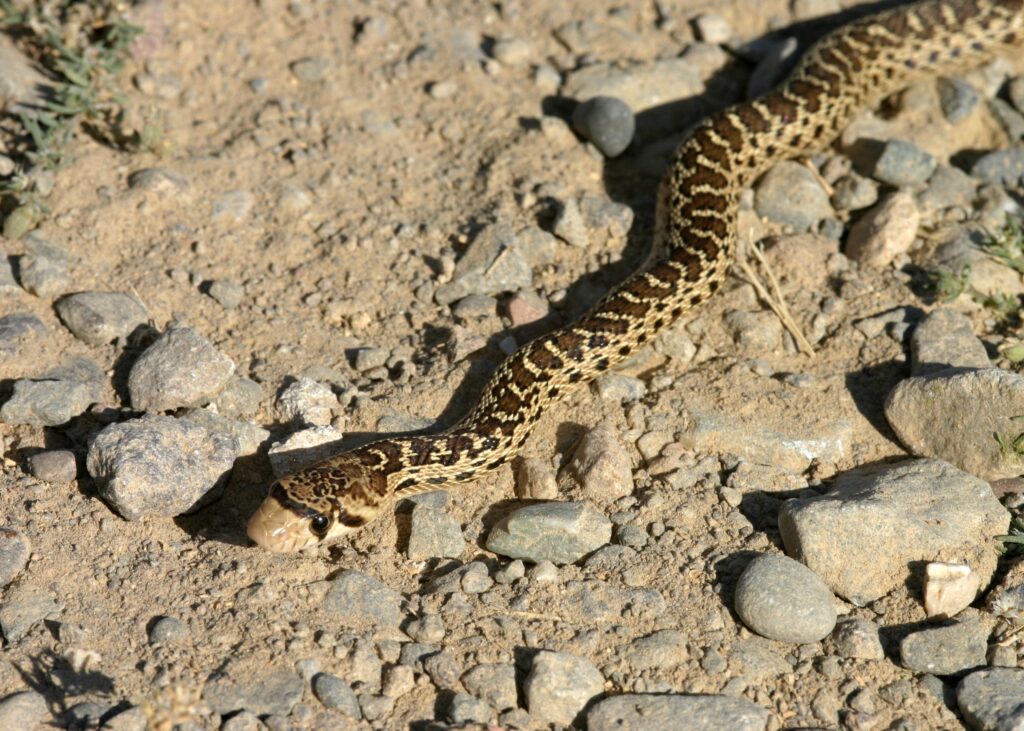
The Gophersnake is commonly mis-identified as a Rattlesnake due to the pattern on its skin. This snake is harmless to humans and is extremely helpful in keeping rodents and other pests away from homes. If you see a Gophersnake, give it space and let it pass. Please do not kill it!
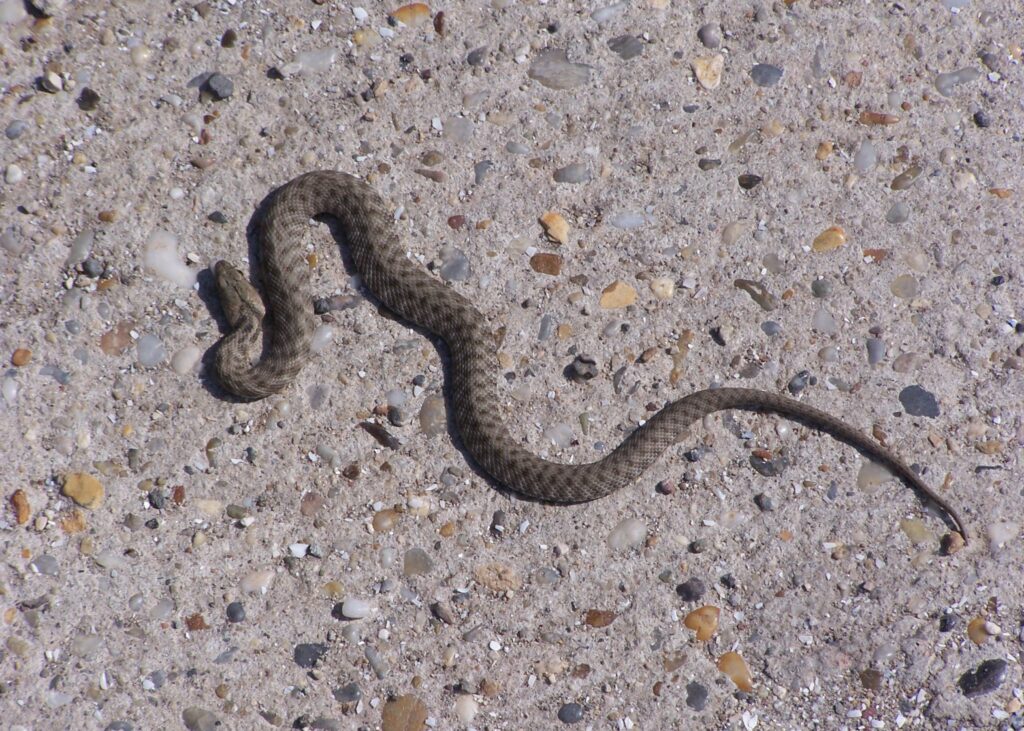
The easiest way to identify the difference between Gophersnakes and Rattlesnakes is this:
- Gophersnake: narrow head, barely pronounced from its body; skinny point tail
- Rattlesnake: triangular head, very pronounced from its body; distinguished rattle at tail (babies have a bulb shape as the rattle develops)
When in doubt, treat any snake that you encounter as being venomous. Proceed on the side of caution, especially with kids in tow, and keep as much of a distance from the snake as possible.
California Kingsnake
How to identify: the skin color is black or brown with white or yellow stripes (running perpendicular to the length of the snake)
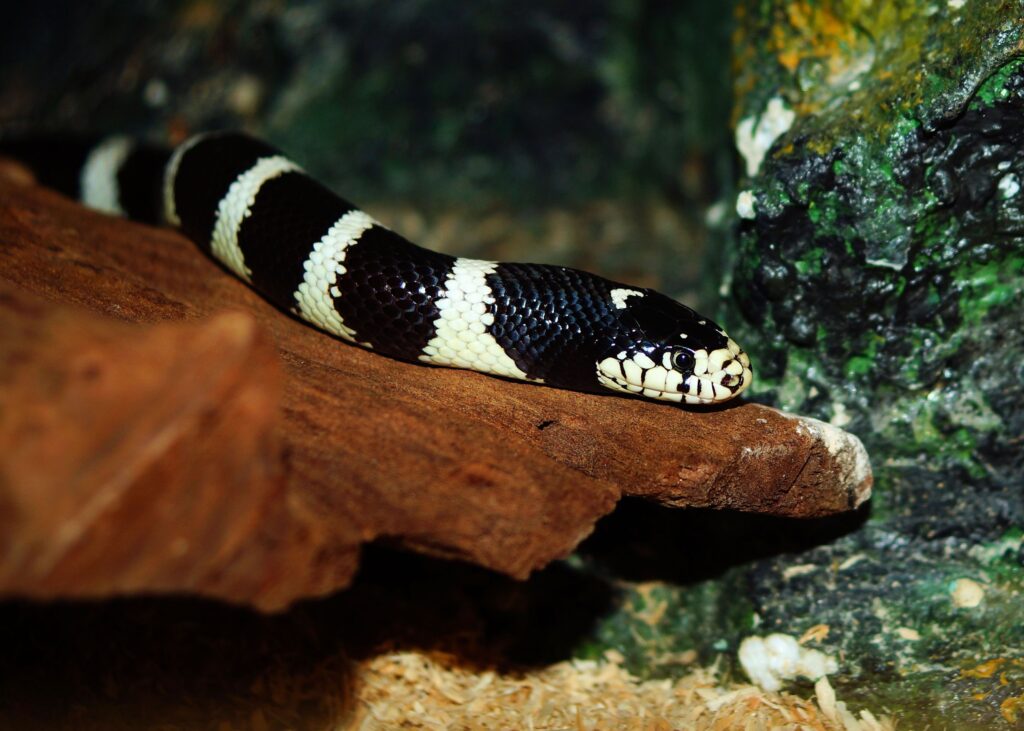
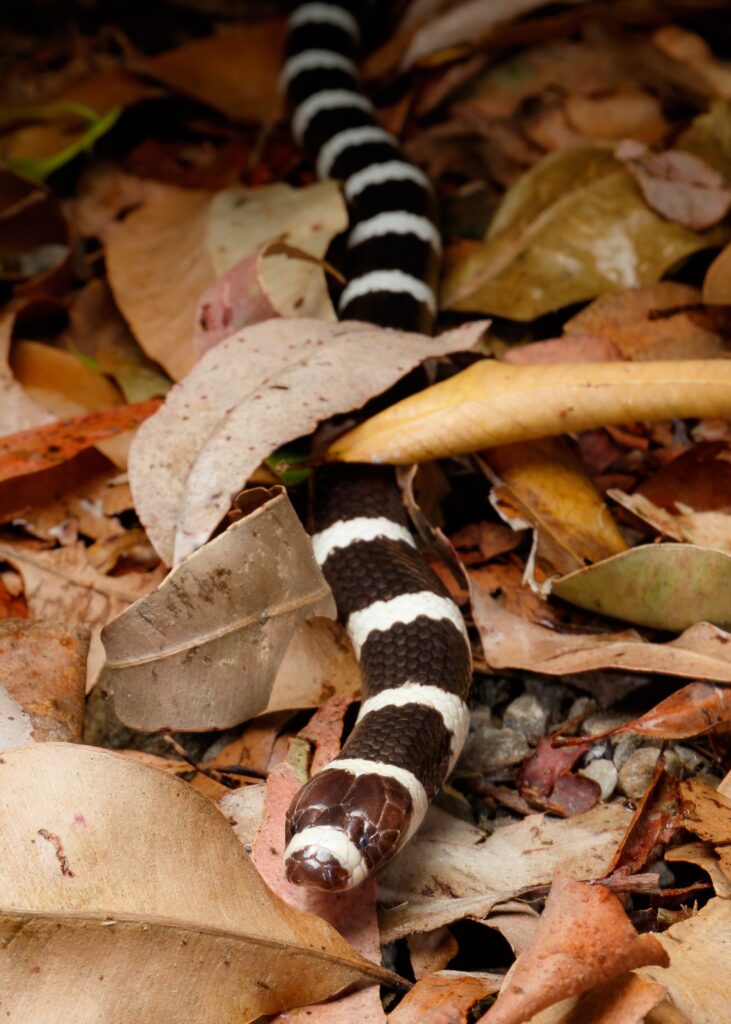
Gartersnake
How to identify: the skin color is usually black with yellow stripes running the length of the snake. The head is narrow and barely wider than its body.
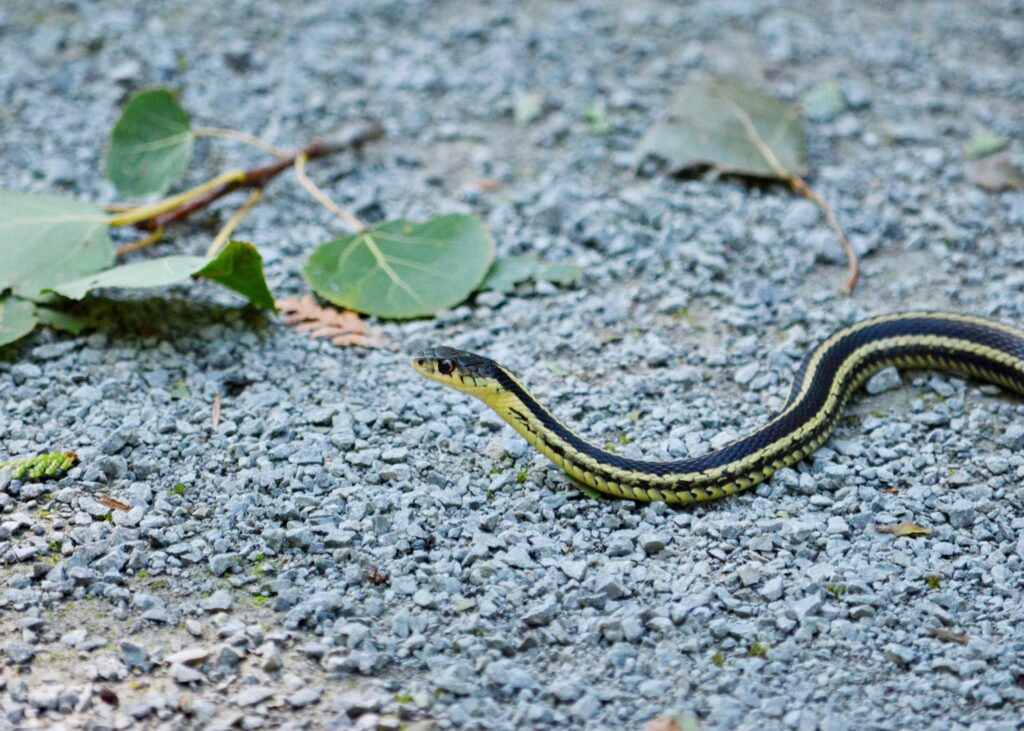
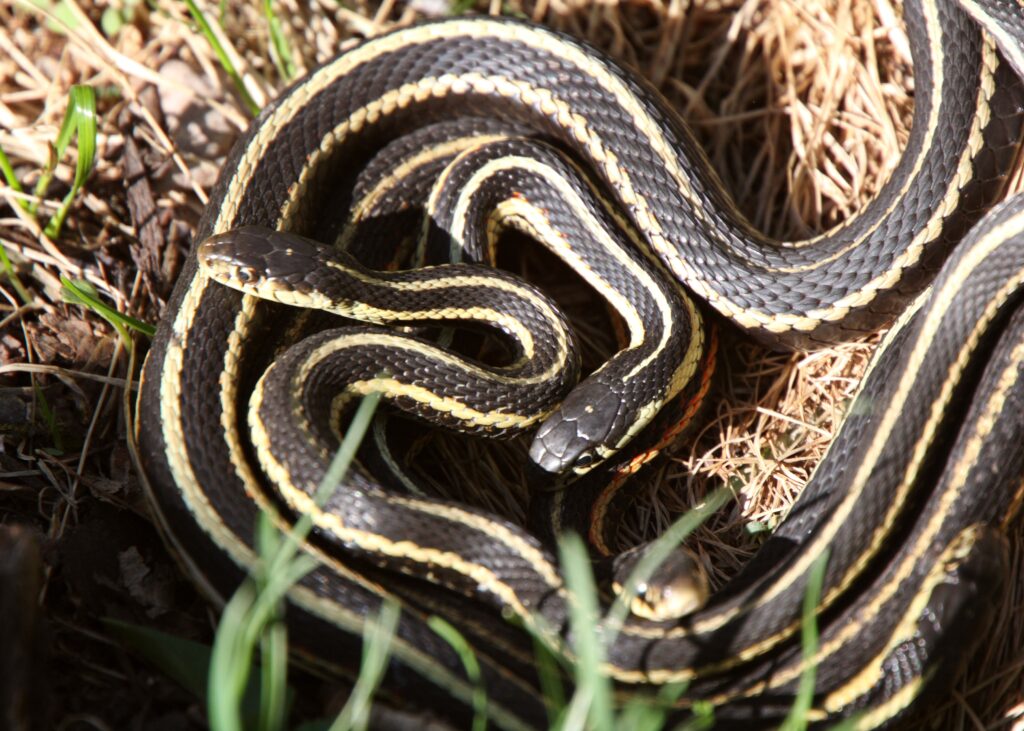
HOW TO AVOID SNAKE ENCOUNTERS WHILE HIKING:
The number one way to avoid snake encounters is to be extremely aware of your surroundings. Know how to identify snakes and where to look for them in their common resting places on the trail.
Step 1: Keep your hiking situational awareness activated and do not block your hearing with headphones.
Rattlesnakes usually will give a warning rattle sound. Make sure you are always looking and listening for their warning signs.
Step 2: Know where to look for snakes and what areas of the trail to avoid
Common hiding places are: under bushes, in chaparral, under overgrown areas, in tall grass, in between rocks, under logs. It is highly recommended to have clear visibility before traveling through any of these areas.
Step 3: If you do come across a snake (especially a rattlesnake) make sure to stop, give it space, and back away safely until it passes.
If I was in a situation where a rattlesnake was on the side of a very narrow trail, coiled and rattling, I would not try to pass.
A rattlesnake can strike ½ of its overall body length from a coiled position. This means that if a 4 foot rattlesnake was coiled, it could “spring” a 2 foot distance. For this reason, I would not pass a rattlesnake unless I had a generous amount of feet between us. Considering that I can’t accurately measure a coiled snake, I’d allow several feet between us (definitely no less than 5 feet to be safe, especially since I’m usually with kids).
The Western Diamon-backed Rattlesnake is the largest in California and can grow up to 7 feet. This means that it can strike 3.5 feet from it’s coiled position. For this reason, I’ve decided that 5 feet is my minimum radius for passing a snake so I can be extra, extra cautious.
Usually, when a rattlesnake doesn’t feel threatened by you, it will continue on its way and get back to hiding off of the trail. The best plan of action is to stay calm, still, and give it space.
The same goes for the other kinds of common snakes. I am choosing to highlight the rattlesnake the most since it is usually everyone’s highest concern.
TEACHING KIDS HOW TO AVOID SNAKES ON THE TRAIL:
I have been in a bunch of conversations in my DM’s on Instagram recently with other moms and there is a very common trend between all of us: we’re all pretty terrified of our young kids encountering a rattlesnake.
Here’s a few tips for avoiding snake encounters with kids:
- Gently remind them before every hike to be on the lookout for snakes. For older kids, you can mention the areas that they hide and remind them to stick close to you. Obviously, for toddlers that walk on their own, reminding them about snakes means next to nothing to them. The way that I handle this is to give proactive reminders such as, “We hold hands and stay close together when we hike on the trail!”, and if my toddler were to consistently run away or run off the trail, I’d warn that she would have to go in the carrier or we’d have to be done hiking for the day if she didn’t stick next to me. My kids can definitely be pretty rambunctious as little toddlers, but I’ve found success in giving proactive guidance and telling them that they would be able to roam freely when we stop for lunch or play after the hike.
- Do not let kids run far ahead to areas of the trail that the adult can’t clearly see. I don’t want my kids to feel like they’re on a super short metaphorical leash, but when it comes to avoiding snake encounters, I will be more strict about trail rules. A great way to navigate this is to hike somewhere where they can have lots of space to play freely during a lunch break or after the hike is done (after you’ve made sure the coast is clear of snakes). Then, while hiking, hopefully they won’t want to run ahead.
- Do not let kids run through tall grass, overgrown areas of the trail, through bushes. Our most recent rattlesnake sighting was right on the side of the trail in tall grass. The best way to show kids how to avoid encounters is to teach them not to wander off the trail (there’s many other reasons that going off trail is strongly advised against, too).
- I always repeat to my kids: “SEE YOUR FEET!” Meaning, always be in a place on the trail where you can clearly see your feet and the surrounding area. Don’t walk off somewhere that is overgrown so you can’t see where you are stepping your foot. Guide kids to be able to quickly decide if something is clearly safe or a higher risk.
I always try to be proactive about our trail rules instead of reactive. I try to give gentle reminders before my kids approach a limit that I’m not comfortable with. For example, I’ll remind them periodically that we’re going to hike close to one another, or I’ll remind them that the trail is about to get more narrow, therefore we’re going to keep a closer eye out for wildlife. Dropping these calm reminders ahead of them happening helps us keep the trail chaos low and doesn’t cause my kids to panic about something going wrong.
I have been practicing trail situational awareness with my 7 year old consistently for the past 5 years since she started hiking on her own, and she is a super confident and aware little hiker! It definitely pays off to teach kids the process of being aware and making good decisions, instead of reacting after something has gone wrong. The best way to do this is by modeling it and talking through your decision making process.
Additionally, in the car on the way to our hikes, I have the same conversation with my daughters every single time. I’ve written about this in detail in my post called How To Respond To A Mountain Lion Encounter, and I’ll explain it here, too. Here’s how the conversation goes:
“Today, we are hiking in __________. In this place, we always keep an eye out for passing mountain bikers, rattlesnakes, poison oak, and ticks in tall grass. Other wild animals that live in these mountains are deer, coyotes, raccoons, and mountain lions. They do not want to see us, so right now we don’t need to be worried. We’re always prepared and ready to keep ourselves safe.
What do you have in your backpack that’s ready to use if you need?“
I receive an answer along the lines of:
“I have my water, my card with your phone number, my rescue whistle, and my snack.”
I respond with, “Great! Let’s go have FUN!”
Having a proactive chat about hike safety reminders really helps my kids and I activate our situational awareness AND have low-stress fun. This way, we remember what to look out for without calling in anxiety about things that could go wrong.
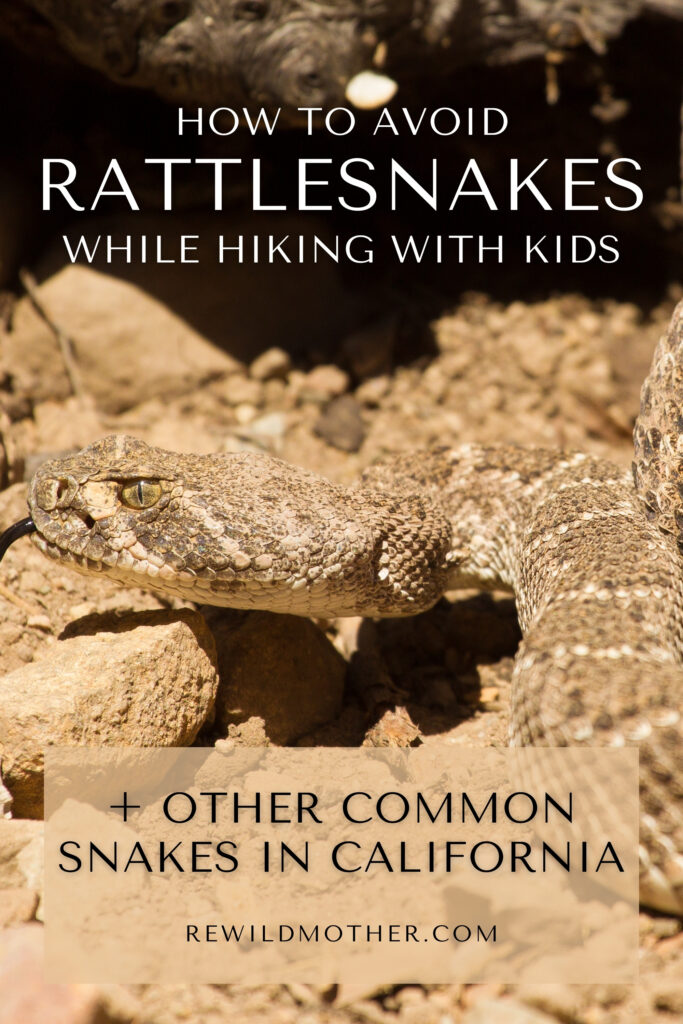
WHAT TO DO IF YOU OR YOUR CHILD IS BITTEN BY A RATTLESNAKE:
Disclaimer: This is my personal protocol for responding to a rattlesnake bite on the trail and is not intended to be medical advice to readers.
Let’s start this off by saying that I strongly hope that no one ever needs to refer to this section. However, as mentioned above, having a game plan to be able to handle emergency situations while out with kids on the trail is always a great idea. Personally, I feel much more confident and at ease when I visualize how I’d successfully handle an emergency situation. It helps me not become anxious about the unknown. If you are similar, this section is for you.
General tips for responding to snake bites:
- Get away from the snake, then sit on the trail and request help. Don’t try to run away because doing so could circulate the venom through your blood stream due to increased heart rate.
- Keep your mind and body calm. Try not to panic and keep your heart rate as relaxed as possible.
- Keep the site of the bite lower than your heart. For example, if you were bit on your ankle, don’t lay down and elevate your leg. Make sure that the site of the venom is not traveling towards your heart, either by gravity or by increased heart rate.
- Call for rescue and wait
If I were to get bitten by a rattlesnake while hiking alone with my kids, here’s what I’d do:
- Get all of us away from the snake. Ideally, I’d find a place to rest in the shade without traveling far. While I’m moving to our resting place, I’d try to take it as easy as possible to keep my heart rate calm.
- Once we get into our spot, I’d rest the bite area lower than my heart.
- I always hike with a Sharpie so I can outline the bite/reaction area and write the time. This way, once rescue arrives and I would receive medical treatment, they can see how much the reaction site has grown and have the exact time of the bite without relying on my memory (that would probably be super stressed at that point). I heard this tip from a firefighter and made it a habit to always keep a Sharpie with me just in case!
- Next, I’d call for rescue. Most likely, I would not try to hike us back to the car because I wouldn’t want to circulate the venom through my system as much as possible. If I’m in an area where cell service is limited or non-existent, I’d grab my Garmin inReach. I’d get in touch with my emergency contact(s) via text or use the SOS feature to directly contact Search and Rescue.
- Then, we’d wait. I’d keep my situational awareness activated and scanning our surroundings for other people and wildlife. I always make it a habit to carry extra snacks and water with me in case we are on the trail longer than expected, so hopefully we’d have plenty of delicious and entertaining snack options.
If my child were to get bitten by a rattlesnake, here’s what I’d do:
- Get all of us away from the snake, then assess her bite. I’d try to stay super calm so that she stays calm as well. I’d remind her that she’s going to be ok and I’m going to get us help.
- I’d outline the bite/reaction site with a Sharpie and note the time.
- After assessing her bite, I’d get in contact with my (pre-determined) hike emergency contacts. I’d get them ready to help me, either by meeting me at the trailhead parking lot or the ER. (Note: I talk about having a hiking safety contact in my post, Safety Tips for Hiking With Kids. Definitely check it out after reading this post!)
- Next, I’d carry my child to the car as fast as I could while keeping her comfortable, stable, and with the bite site lower than her heart. Since I’m pretty much always hiking with both my kids, I’d have my other child stay right at my side, and continue practicing our awareness for wildlife on the trail.
Note: I personally would not recommend treating the bite unless you’ve taken a comprehensive Wilderness First Aid course. Definitely go with your own gut instinct here, but my recommendation would be to get to emergency services as fast as possible instead of attempting to treat it on the trail without proper training. As always, my suggestion is just my personal opinion and I encourage everyone to go with what their gut instinct tells them to do.
If a rattlesnake is on your home property, here is a FREE SNAKE RELOCATION DIRECTORY:
Here in California (and all across the U.S., too) there are many professional snake handlers that have agreed to volunteer their time to removing snakes from people’s yards/properties. They do this to encourage homeowners to call for removal instead of killing the snake onsite. While we certainly don’t want a close encounter with rattlesnakes at home or on the trails, they really do play a very important role in the wild.
If you see a snake in your yard:
- Keep your eyes on it at all times. It can disappear in a single minute and be nearly impossible to find.
- Contact the snake relocator closest to you as listed in the Directory linked below. For our area, it is requested to text the relocator first instead of calling. Proceed however you see fit.
- Continue keeping your eyes on the snake until the relocator arrives and show them where the snake is located.
- DO NOT contact a relocator if: the snake is already dead, you are on a hiking trail or in a campground (aka anywhere besides your personal home property), or if days have passed since the last sighting.
FREE SNAKE RELOCATION DIRECTORY LINK
I know this was a ton of info thrown at you all at once about a topic that’s pretty terrifying to think about. However, I really do hope that it helped you visualize that you absolutely CAN handle (and avoid!!) snake encounters while on the trail with your kids.
Make sure you drop your email in the box below so you don’t miss out on my next newsletter. I’ll be sending out a Mother’s Day Gift Guide soon that will be super easy to pass along to those who think you are the best mama around.
And if you aren’t already there, come hang out with us over on Instagram!
Last reminder! Head over to iNaturalist and scroll through all of the snakes in your area. You can do this by clicking the ‘Explore’ tab, entering your state and “snakes” in the search bar. See how many you can identify and familiarize yourself with the similarities and differences between them.
Until the next one –
xx,
Kaleigh
Sources:
https://californiaherps.com/identification/snakesid/common.html
https://californiaherps.com/snakes/pages/l.californiae.html
https://californiaherps.com/identification/snakesid/gophersnakes.id.html
https://californiaherps.com/identification/snakesid/gartersnakes.id.html
https://www.inaturalist.org/observations?place_id=14&taxon_id=85553&view=species
https://crofab.com/envenomation-education/snakes-in-your-state.html
https://reptile.guide/california-snakes
Disclosure: Please assume that any / all of the product links throughout this website are affiliate links. Shopping these links returns a commission to the site owner at no extra cost to the customer. Rewild Mother / Kaleigh Eliza is a participant in the Amazon Affiliate LLC program where commissions are earned. Thank you so much to everyone who shops my links and directly supports my mama-run small business!
Great article! I really appreciate the clear and detailed insights you’ve provided on this topic. It’s always refreshing to read content that breaks things down so well, making it easy for readers to grasp even complex ideas. I also found the practical tips you’ve shared to be very helpful. Looking forward to more informative posts like this! Keep up the good work! YouTube Downloader Online